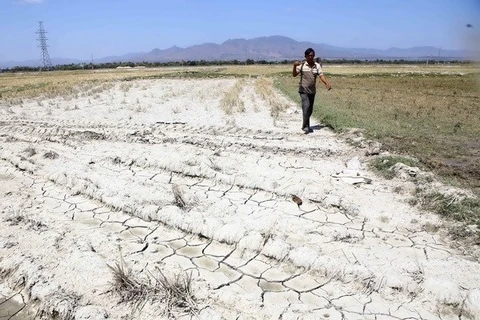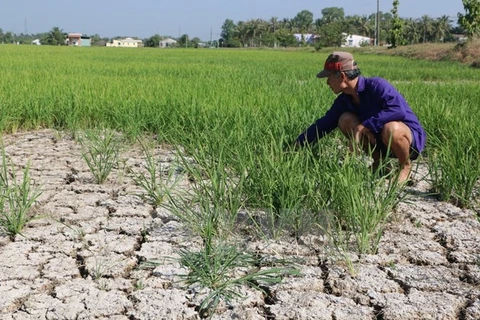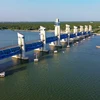 Salt intrusion caused loss to rice fields in Mekong Delta region. The Mekong Delta province of Tra Vinh introduced its standout agricultural production models adapting to climate change carried out under the “Adaptation in the Mekong Delta” (AMD) project.
Salt intrusion caused loss to rice fields in Mekong Delta region. The Mekong Delta province of Tra Vinh introduced its standout agricultural production models adapting to climate change carried out under the “Adaptation in the Mekong Delta” (AMD) project. Tra Vinh (VNA) – The Mekong Delta province of Tra Vinh introduced its standout agricultural production models adapting to climate change carried out under the “Adaptation in the Mekong Delta” (AMD) project at a conference held in the locality on September 8.
According to Huynh Nghia Tho, director of the AMD Tra Vinh’s coordinating board, the project has been carried out in 30 communes and benefits 15,000 poor and near-poor rural households since 2014. It is set to finish in 2020.
It aims to develop sustainable livelihoods for the rural poor in the face of changing climate as well as improve the community’s capacity to response to climate change.
Thanks to financial assistance from the climate change adaptation co-sponsoring fund (CCA) under the International Fund for Agricultural Development (IFAD), 18 agricultural livelihood models were piloted in the locality in 2015. Those included 13 cultivating models, four on livestock breeding and one on aquatic farming.
Farmers involved in such models were supported with input materials like breeds, fertiliser and pesticides. In addition, they were assisted with machines and equipment and cultivating guidance as well as how to fertilise appropriately.
Each poor and near poor household received a financial support of 30 million VND (1,320 USD) while the financial assistance for every business household and cooperative were 100 million VND (4,400 USD) and 750 million VND (33,000 USD), respectively.
Vice Chairman of the provincial People’s Committee Kim Ngoc Thai said that the models have brought high economic efficiency and generated more incomes for local people, contributing to the construction of new-style rural areas.
Chili pepper model cultivated in an area of 2.3 hectares by Thang Loi 2 Cooperative in Thach Hoa Son commune, Cau Ngang district is one of the excellent examples. New cultivating method helped the cooperative’s productivity rise 5 tonnes per hectare while the pepper has been sold at 1,000 VND higher than when it was grown in the traditional way.
The model on farming oysters on floating rafts developed by Dai Thanh Cooperative in Long Khanh commune, Duyen Hai district is showing efficiency as oyster cultivation does not feel much impacts of climate change and it is suitable for families without production land.-VNA
VNA
























